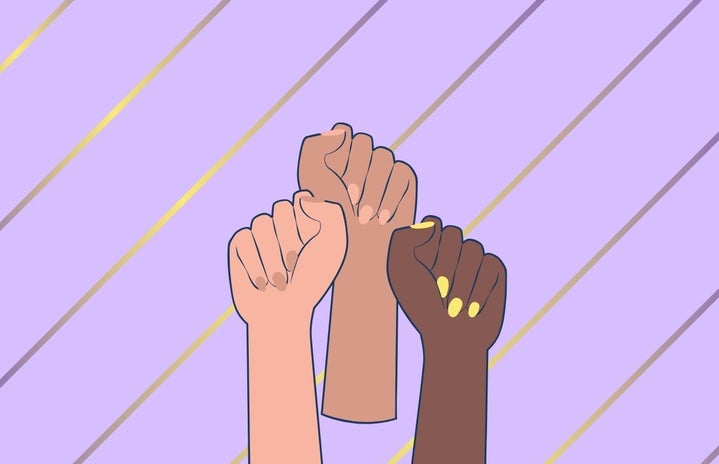Every year since the early 1900s, March 8th has been dedicated to women and the whole month has been dedicated to the history of women. Not just one, not just a few, but all women. Throughout the several decades of appreciation, women have been faced with a myriad of opposition and struggle. International Women’s Day is a time to acknowledge our progress and to appreciate those who fought for us to live a better today. Let’s take a trip down memory lane and see just how far we’ve come throughout the generations of feminism.
The first wave of feminism marks the first time people saw a real need for change. This is not to say women before never saw it, but it was an acknowledgment the governments made as thousands of women in the U.S. started a political movement for women’s equality. It began with Elizabeth Cady Stanton’s delivery of “Declaration of Sentiments” in Seneca Falls, NY. As she aired her grievances, she inspired a generation of women to demand representation.
The first wave movement was also deeply devoted to abolishing slavery. Black female leaders like Sojourner Truth, Maria Stewart, and Frances E.W. Harper aimed toward universal suffrage. However, as the 15th Amendment was passed, allowing Black men to vote, the first wave white women decided they needed to focus on their own suffrage more than their Black counterparts. As the movement made progress in regards to reproductive rights, employment opportunities, education, and the eventual passing of the 19th Amendment in 1920, there was obviously still change needed. The first wavers did not understand that it’s not feminism if it’s not intersectional. Alas, there was work to be done.
When people think of feminism today, most think of the second wave. Do Betty Friedan, Gloria Steinem, or Shirley Chisholm ring a bell? They should. In 1963 Friedan released her book, The Feminine Mystique. This radicalized a movement of women that stemmed from all backgrounds. From housewives to young students Friedan ignited a spark with her words on systemic sexism. The Feminine Mystique allowed for women to have access to education on these issues for the first time. The accessibility granted them the ability to put the issues they always knew about into words. At the same time in France, a similar movement was developing as Simone de Beauvoir’s Second Sex was rising in popularity. The women of the world were waking up.
This movement fought for social equality. Carol Hanisch created the phrase “the personal is political”, which acknowledged how issues like sex, relationships, reproductive health, and discrimination were all just as political as voting. These women achieved some major legislative victories such as The Equal Pay Act (1963), Title IX (1972), and Roe v. Wade (1973). They prospered as unmarried women were granted access to birth control, women received the right to hold a credit card in their own name and legislated against sexual harassment in the workplace.
Although these achievements were pivotal, this movement lacked in the same ways the first wave did. During this time, the Civil Rights Movement was heavily underway as well. Although the second-wave feminists were mainly anti-capitalistic and anti-racist, they failed to be inclusive in much of their rhetoric. The Feminine Mystique was relatable to mostly white, middle-class women. Instead of joining in solidarity, the white women neglected to protest for issues that only affected Black women like the forced sterilization of people of color and people with disabilities. In America, the Black female community created their own movement called womanism. This movement emphasized issues that affected women of color as well as the same issues white feminists were fighting for. The term coined by Alice Walker created a larger feminist framework, allowing for a safe space for all women.
The second wave began to dissolve in the 1980s Regan-era of conservatism. The image of radical women became unappealing as some women saw it to be all for show rather than real change. Although the movement won many battles, there were still many to be had.
There is a lot of debate about when the third-wave feminist movement emerged, but there was no doubt that they were there. Scholars note the beginning to be the Anita Hill case in 1991. Hill testified in front of the Senate Judiciary Committee, telling her story of how Supreme Court nominee, Clarence Thomas, sexually harassed her. As she came forward with her story, a storm of sexual harassment complaints came about as women were inspired by her bravery to come forward with their stories. As the government still sat Thomas on the Supreme Court, women across the U.S. acknowledged the overrepresentation of men in government. This led to “the Year of the Women” in 1992 as 24 women were elevated to the House and 3 to the Senate.
Around this time Kimberlé Crenshaw’s term “intersectionality” rose in popularity amongst feminists. Women were finally recognizing that all forms of oppression, like racism and homophobia, all intersect with sexism. Judith Butler’s ideas on how gender is simply performative also piqued the interests of third-wave feminists. Crenshaw and Butler’s ideas had heavy influence over this movement, making it the most inclusive yet.
On another side of the spectrum, the Riot Grrrl movement was on the rise amongst the music scene. Kathleen Hanna, the co-founder of the movement and lead singer of Bikini Kill, penned the Riot Grrrl Manifesto. Her fanzines included literature about inclusivity and how women needed to build a strong community to protect one another. She famously wrote, “BECAUSE we are angry at a society that tells us Girl = Dumb, Girl = Bad, Girl = Weak.” Feminist punk bands like Bratmobile and Sleater-Kinney emerged throughout this era. Their lyrics consisted of criticisms of the societal standards set for women and the overall reality of life as a woman. Their sound then reflected the angst and determination they had to reject idealized stigmas around women. The movement worked to take back certain girly aesthetics as well as normalize masculine ones, noting that a woman could be anything she wants and that it’s inherently misogynistic to reject anything that’s too “girly” or too “manly”.
Besides “the Year of the Woman”, there was not a lot of concrete change made by women legislatively. This change was one of societal standards and style. As women began to enter traditionally male-dominated arenas like music and government, the increased representation. That representation redefined how a woman could look and act, proving that they were just as powerful.
The fourth wave of feminism has been building up for a while now, but the heat of it all is occurring now. As the #MeToo and Time’s Up movements gained traction, traditions like the Women’s March began. These are a branch of the third wave’s goals of condemning and receiving justice for sexual harassment as well as normalizing women’s sexual freedoms. The fourth wave’s biggest asset has been the internet. Feminists are able to organize, educate, and debate on social media platforms. This helps to ensure the fight stays consistent and inclusive. Online platforms allow people all over the world to ignite this discourse, creating a massive coalition for equal rights.
Today, more women than ever before have been running for office in countries all across the world. Currently, 29 countries have appointed women to run the country. Currently, in the United States, 119 women make up the House of Representatives (27%) and there are 24 in the Senate (24%). Of those numbers, only 36% of the women serving in Congress are women of color. Although this is a vast improvement from years before, there is still action that needs to be taken in order to reach equal representation.
Other fourth-wave campaigns like the Slutwalks are about society recognizing the dangers of being a woman. They enforce the idea that we should be teaching men not to rape rather than telling women not to dress a certain way to prevent being raped. Women are working to have institutions, mostly universities, provide better protection in this regard by believing women and recognizing that this plague of sexual assault and harassment need to be squashed.
Inclusivity is at the heart of this wave. Feminists are not only holding men accountable, but each other as well to recognize the intersectionality of oppressions. This wave is about recognizing the dark cloud the patriarchy has historically cast over anyone who is not a white man. The adoption of intersectionality had helped communities to stand in solidarity as rates of discrimination increase.
Feminism has come a long, long way. Generations of feminists alike have adapted and persisted to pursue true equality. As always, there is still more to be done. There have recently been several attacks on the transgender community and on reproductive rights. Governments are fighting to reverse the progress feminists have fought hundreds of years for. The momentum can never stop. As each day presents a new battle for equal rights, our perseverance never waivers. So, this International Women’s Day let’s remember the ancestors before us who not always perfectly, but relentlessly and radically charged forward towards change. Let’s carry the torch that holds the flame sparked by those in the early 1800s towards the equality we deserve.


